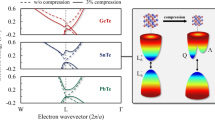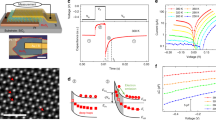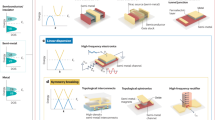Abstract
The thermodynamics of semiconductor based chemical sensors is examined. Depending on the structure, both ionic and neutral species can be detected. A reference electrode is required only if an ionic species is involved and there is no interaction by surface states at the semiconductor–sensor material interface. If any chemical process at the solution–sensor interface frees a defusing species which interacts with the semiconductor interface, then it may be feasible to dispense with an external reference and use the internal Fermi level of the semiconductor as the reference. A parallel argument is presented for neutral species leading to the well known Henry's law for gas phase doping of semiconductors. In both neutral and ionic detection, rapid forward and reverse processes are essential for ‘reversible’ detection.
This is a preview of subscription content, access via your institution
Access options
Subscribe to this journal
Receive 51 print issues and online access
$199.00 per year
only $3.90 per issue
Buy this article
- Purchase on SpringerLink
- Instant access to full article PDF
Prices may be subject to local taxes which are calculated during checkout
Similar content being viewed by others
References
Zemel, J. N. Analyt. Chem. 47, 255A (1975).
Zemel, J. N. Res. Dev. 28, 38 (1977).
Kelly, R. G. Electrochim. Acta 22, 1 (1976).
Bergveld, P. IEEE Trans. Biomed. Engng BME-19, 342 (1972).
Matuso, T. & Wise, K. D. IEEE Trans. Biomed. Engng. BME-21, 485 (1974).
Moss, S. D., Janata, J. & Johnson, C. C. Analyt. Chem. 47, 2238 (1975).
Bergveld, P. Biomed. Engng 11, 359 (1976).
Janata, J. & Moss, S. D. Biomed. Engng 11, 241 (1976).
Rechnitz, G. A. Science 190, 234 (1975).
Bates, R. G. Determination of pH: Theory and Practice (Wiley, New York, 1973).
Eisenman, G. (ed.), Glass Electrodes for Hydrogen and Other Cations (Dekker, New York, 1967).
Durst, R. A. (ed.) Ion Selective Electrodes, NBS spec. Publ. 314 (1969).
Desoer, C. A. & Kuh, E. S. Basic Circuit Theory (McGraw-Hill, New York, 1969).
Schwabe, K. & Dahms, H. Z. Electrochem. 65, 518 (1961).
Zemel, J. N. Intern. Electron Devices Meeting, Washington, D. C., 635 (1975).
Keramati, B. & Zemel, J. N. AEMB, Los Angeles (1977).
Grove, A. S. Physics and Technology of Semiconductors Devices (Wiley, New York, 1967).
Buck, R. P. & Hackleman, D. E. Analyt. Chem. (in the press).
Kingston, R. H. & Neustadter, S. F. J. appl. Phys. 26, 718 (1955).
Gerischer, H. Adv. Electrochem. Electr. Engng 1, 139 (1960).
Esashi, M. & Matsuo, T. Suppl. J. Japan Soc. appl. Phys. 44 (1975).
Bergveld, P. & de Rooij, N. F. Theory, Design and Biomedical Appfication of Solid State Chemical Sensors (CRC Press, Cleveland, 1977).
Ahmed, S. M. J. Phys. Chem. 73, 3546 (1969).
Cline, H. E. & Anthony, T. R. J. applied Phys. 47, 2325 (1976).
Author information
Authors and Affiliations
Rights and permissions
About this article
Cite this article
Bergveld, P., DeRooij, N. & Zemel, J. Physical mechanisms for chemically sensitive semiconductor devices. Nature 273, 438–443 (1978). https://doi.org/10.1038/273438a0
Received:
Accepted:
Published:
Issue date:
DOI: https://doi.org/10.1038/273438a0
This article is cited by
-
Simultaneous DNA amplification and detection using a pH-sensing semiconductor system
Nature Methods (2013)
-
From conventional membrane electrodes to ion-sensitive field-effect transistors
Medical and Biological Engineering and Computing (1979)
-
Electronic-circuit-design principles for parameter control of i.s.f.e.t.s and related devices
Medical & Biological Engineering & Computing (1979)



